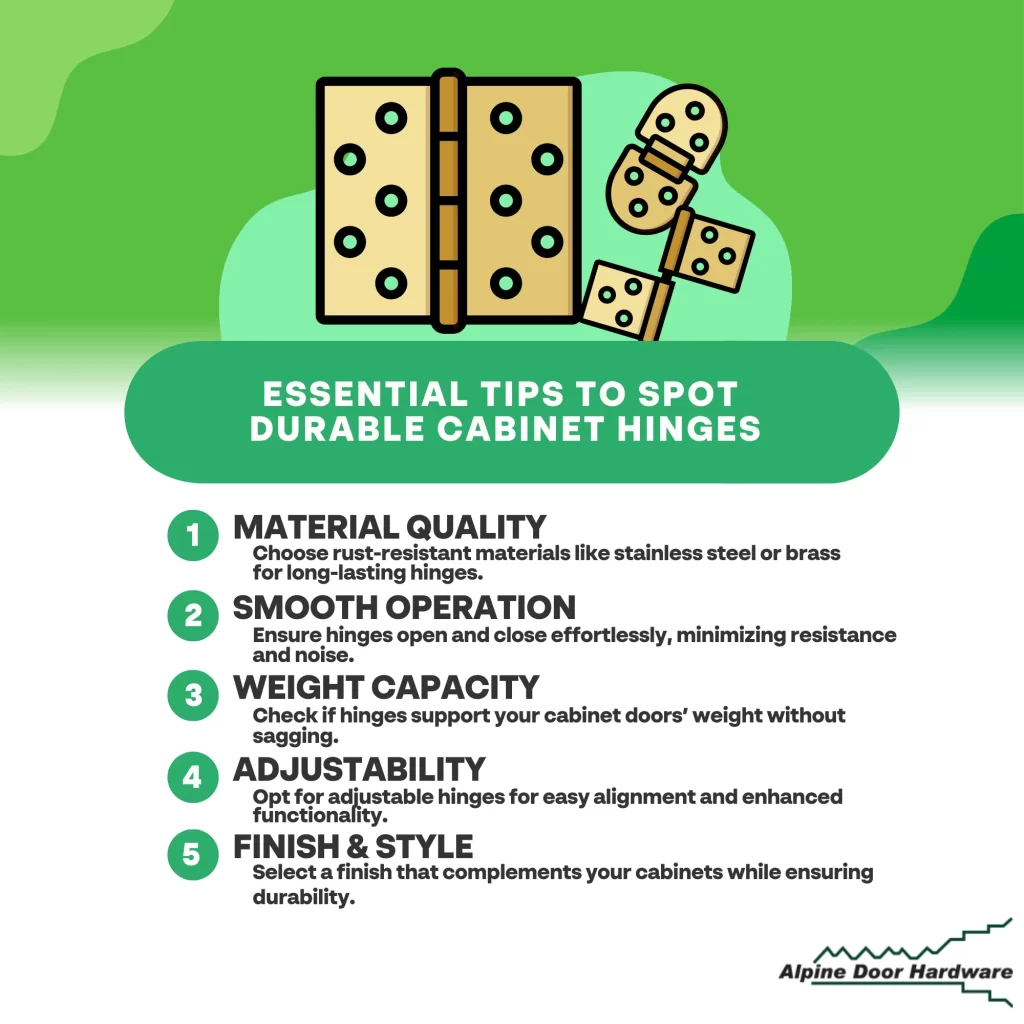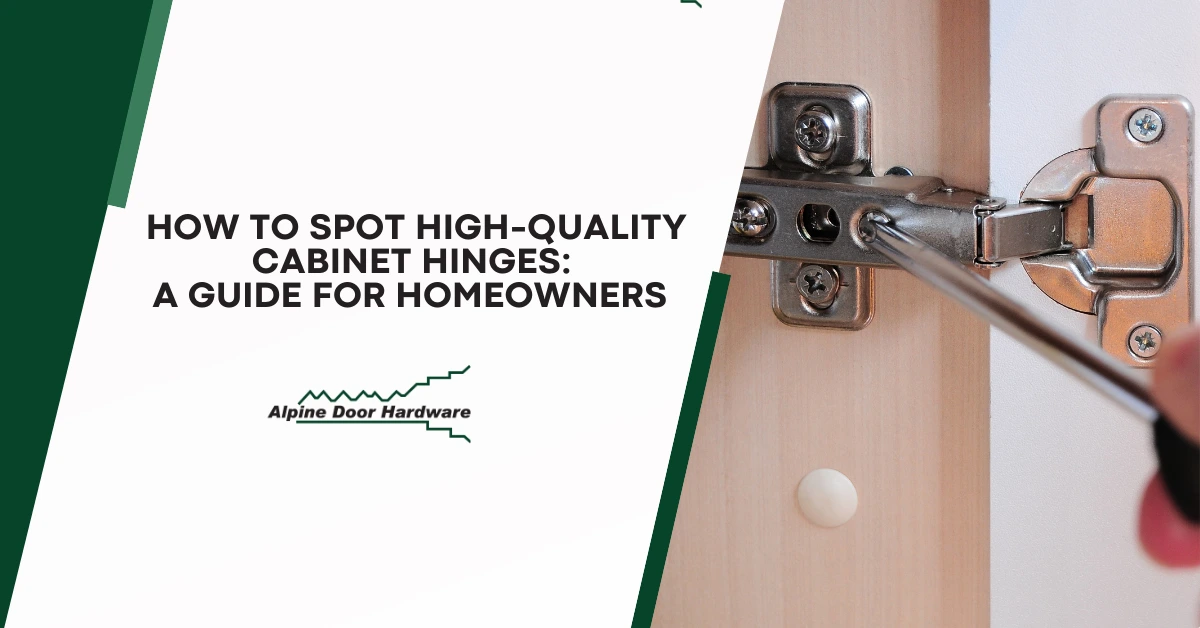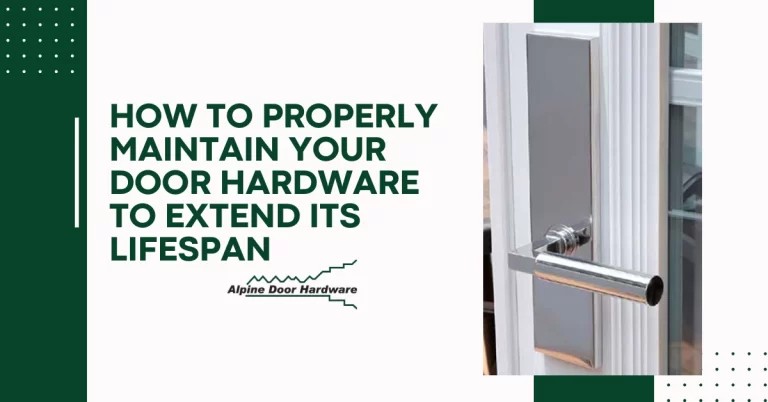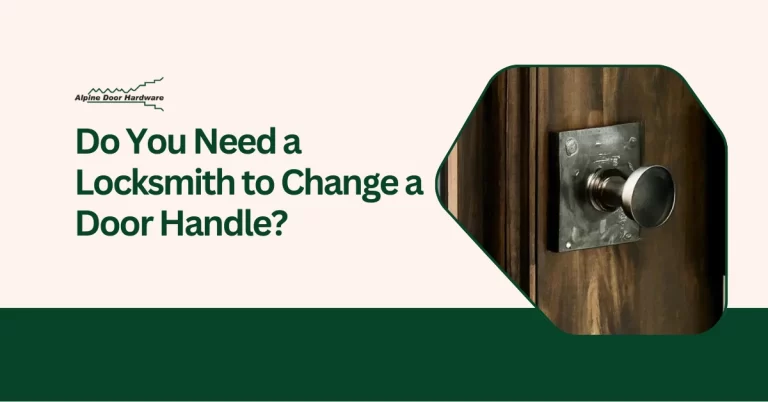To spot high-quality cabinet hinges, you should start by checking the material; look for rust-resistant options like stainless steel or brass. Verify the hinges feel sturdy and operate smoothly—wiggle them gently to detect any resistance. Choose adjustable hinges for easy alignment and functionality, which is crucial for seamless door operation. Consider the hinge type based on your cabinet door style and weight; heavier doors require more robust designs. Finally, inspect the finish for durability and esthetic appeal. By keeping these factors in mind, you’ll enhance your cabinetry’s longevity and performance. There is essential information ahead to guide your selection.

Key Takeaways
- Material Quality: Look for hinges made from rust-resistant materials like stainless steel or brass for durability and longevity.
- Smooth Operation: Test hinges for effortless opening and closing; quality hinges minimize resistance and noise during use.
- Weight Capacity: Ensure hinges can support the weight of your cabinet doors by checking the manufacturer’s specifications for weight limits.
- Versatility: Choose hinges with adjustable features to fine-tune door alignment easily after installation, enhancing functionality.
- Finish and Aesthetic: Select hinges that match your cabinet style and finish, ensuring they complement your overall decor for visual appeal.
Common Types of Cabinet Hinges
When choosing cabinet hinges, it’s crucial to recognize the common types available to you. Each type, from European concealed hinges to butt hinges, offers unique advantages for different cabinet styles and needs. Understanding these options will help you make an informed decision that enhances both functionality and esthetics in your space.
1. European Hinges (Concealed Hinges)
European hinges, also known as concealed hinges, are a popular choice for modern cabinetry, seamlessly blending functionality with sleek design. These high-quality cabinet hinges are hidden from view when the cabinet doors are closed, creating a clean, streamlined appearance that enhances your kitchen or bathroom’s esthetic.
One of the key benefits of European hinges is their adjustability. You can easily fine-tune the alignment of your cabinet doors, ensuring they close properly and evenly. High-quality options often feature soft-close mechanisms, preventing slamming and ensuring a gentle, quiet close every time.
When choosing European hinges, look for durable materials like stainless steel or brass, as these will stand the test of time. Check for smooth operation; a good hinge should open and close with minimal resistance. Also, consider the weight capacity—ensure the hinges can support your cabinet doors without sagging.
2. Butt Hinges
Butt hinges are one of the most common types of cabinet hinges you’ll encounter, and they offer a straightforward solution for various cabinetry needs. When choosing butt hinges, it’s important to look for high-quality cabinet hardware that guarantees durability and functionality. Here are four key features to take into account:
- Material: Opt for hinges made from robust materials like stainless steel or brass to prevent rust and wear.
- Weight Capacity: Confirm the hinges can support the weight of your cabinet doors without sagging. Check the specifications for recommended weight limits.
- Finish: A good finish not only enhances appearance but also protects against corrosion. Look for powder-coated or polished finishes that match your cabinetry.
- Installation: Choose hinges that come with clear installation instructions and all necessary hardware for a hassle-free setup.
3. Continuous Hinges (Piano Hinges)
If you’re seeking a sturdy and reliable option for your cabinetry, continuous hinges, often referred to as piano hinges, are worth considering. These hinges run the entire length of the door, providing exceptional support and durability. They’re perfect for heavy doors or larger cabinet applications, ensuring smooth operation without the risk of sagging.
High-end cabinet hinges like continuous hinges are made from robust materials such as stainless steel or brass, offering both strength and resistance to wear. Their design allows for a consistent pivoting motion, which means the door opens and closes effortlessly. This feature not only enhances functionality but also contributes to the overall esthetic of your cabinetry.
When installing continuous hinges, you’ll find they’re ideal for both residential and commercial settings, making them a versatile choice. They can be used for everything from kitchen cabinets to office storage, providing a seamless look that complements various interior designs. Plus, with a variety of finishes available, you can easily match them with your cabinetry. So, if you want longevity and style, continuous hinges are a fantastic investment for your home.
4. Inset Hinges
When considering different types of cabinet hinges, inset hinges stand out for their unique design and functionality. These hinges are installed within the cabinet frame, allowing the cabinet doors to sit flush against the frame when closed. This clean esthetic can enhance the overall look of your cabinetry, making them a popular choice among homeowners.
To guarantee you’re choosing quality cabinet hinges, keep these points in mind:
- Material: Look for hinges made from durable materials like brass or stainless steel, which resist wear and corrosion.
- Weight Capacity: Check the weight rating to confirm they can support your cabinet doors without sagging.
- Adjustability: Quality inset hinges often feature adjustable options, allowing you to fine-tune the door positioning after installation.
- Finish: A high-quality finish not only enhances the appearance but also adds to the hinge’s longevity by resisting scratches and tarnishing.
5. Semi-Concealed Hinges
Semi-concealed hinges blend functionality and esthetics, making them a popular choice for modern cabinetry. These hinges are designed to be partially visible when the cabinet door is closed, offering a sleek look while still providing reliable support. They’re ideal for homeowners looking to balance style with durability.
When selecting semi-concealed hinges, consider heavy duty hidden cabinet hinges. These versions offer increased strength, ensuring your cabinet doors operate smoothly even with frequent use. They’re perfect for larger doors or heavy materials, giving you peace of mind that your cabinetry can withstand daily wear and tear.
You’ll also want to check the materials used in these hinges. Opt for options made from high-quality metal to prevent rust and corrosion, which can compromise their longevity. Additionally, look for adjustable hinges that allow for fine-tuning the door alignment, ensuring a perfect fit every time.
Installing semi-concealed hinges can enhance not only the functionality of your cabinets but also their visual appeal. By choosing the right hinges, you can achieve a polished look that complements your overall design while ensuring your cabinetry remains practical and durable.
Factors to Consider When Choosing Cabinet Hinges
When choosing cabinet hinges, you’ll want to take into account several key factors to guarantee you pick the right ones for your needs. Start by evaluating your cabinet door style and whether you prefer concealed or exposed hinges, as these choices can impact both functionality and esthetics. Additionally, think about the weight and size of your cabinets, desired functionality, and the durability of the materials to make an informed decision.
1. Cabinet Door Style
Choosing the right cabinet hinges can greatly impact both the functionality and esthetics of your space. When considering your cabinet door style, you should keep a few key factors in mind to guarantee you select the best quality cabinet hinges that fit your needs.
- Door Thickness: Measure the thickness of your cabinet doors. This will help you choose hinges that provide the right fit and support.
- Overlay or Inset: Determine if your doors overlay the cabinet frame or sit flush with it. Different styles of hinges work best for each configuration.
- Opening Angle: Consider how far you want your cabinet doors to swing open. Some hinges allow for wider openings, which can be helpful for accessing items inside.
- Finish and Material: Match the hinge finish and material to your cabinet doors for a cohesive look. This can elevate the overall esthetic of your kitchen or bathroom.
2. Concealed or Exposed
Understanding the difference between concealed and exposed hinges can greatly influence your cabinet’s overall look and functionality. Concealed hinges are hidden from view when the cabinet door is closed, offering a sleek, modern appearance. This type of hinge is often preferred for contemporary designs, as it allows for a clean line and minimizes visual clutter. On the other hand, exposed hinges are visible when the door is closed, adding a decorative element that can enhance traditional or rustic esthetics.
When choosing between these different types of cabinet hinge, consider the style of your cabinets and the overall design of your space. Concealed hinges tend to be easier to install and offer smoother operation, while exposed hinges can provide a charming, vintage touch. Be sure to assess the durability and material of the hinges as well, as quality will directly affect performance and longevity.
Ultimately, your choice should reflect your personal style and functional needs. By weighing the pros and cons of concealed versus exposed hinges, you can make an informed decision that elevates both the appearance and function of your cabinets.
3. Cabinet Weight and Size
Cabinet weight and size play essential roles in selecting the right hinges for your cabinets, as improper choices can lead to functionality issues and premature wear. To determine what size cabinet hinges do you need, consider the following factors:
- Cabinet Weight: Heavier cabinets require sturdier hinges that can support the added weight without sagging.
- Door Size: Larger doors often need wider hinges for better weight distribution and stability.
- Hinge Type: Different hinge styles, like concealed or exposed, can impact the overall functionality based on your cabinet design and usage.
- Material: Choose hinges made from high-quality materials that can handle the stress of daily use, especially for heavy or frequently opened cabinets.
4. Desired Functionality
When selecting hinges for your cabinets, consider how you want them to function in your space. The desired functionality can greatly impact your overall experience with your cabinets. Think about how often you’ll be opening and closing them. If you frequently access your cabinets, look for quality hinges that provide smooth operation and durability.
Next, consider the type of opening you want. Are you looking for full-overlay doors that cover the cabinet frame, or do you prefer a more traditional inset style? Each type of hinge serves a specific purpose and affects the esthetic of your kitchen or bathroom.
Don’t forget about the weight of your cabinet doors. Heavier doors require sturdier, high-quality hinges to guarantee they operate correctly and don’t sag over time. Additionally, if you’re tight on space, consider hinges that allow for a 90-degree or 180-degree opening, providing easier access to the cabinet interior.
Finally, think about any special features you might need, such as soft-close mechanisms. By evaluating these factors, you’ll find the perfect quality hinges that meet your functional needs while enhancing your cabinetry.
5. Material Durability
Choosing the right material for your cabinet hinges is vital for guaranteeing long-lasting performance and reliability. High-end cabinet hardware often features materials that withstand daily wear and tear, so it’s important to take into account a few key factors when selecting your hinges:
- Material Type: Look for hinges made from solid brass, stainless steel, or high-quality zinc. These materials resist rust and corrosion, enhancing durability.
- Weight Capacity: Verify the hinges can support the weight of your cabinet doors. Heavier doors require sturdier hinges—this matters for both functionality and longevity.
- Finish Quality: A high-quality finish not only adds esthetic appeal but also protects against scratches and tarnishing. Check for options like polished chrome or brushed nickel for added durability.
- Brand Reputation: Opt for well-known brands specializing in high-end cabinet hardware. Their products are often backed by warranties, guaranteeing peace of mind.
6. Cost
Many homeowners might overlook the cost factor when selecting cabinet hinges, but it’s essential to evaluate how it impacts both your budget and the quality of your renovation. While it can be tempting to go for the cheapest option, investing in the best quality cabinet hardware often pays off in the long run.
Higher-quality hinges might come with a steeper price tag, but they typically offer better durability and performance. Cheaper hinges may wear out quickly, leading to the need for replacements sooner than you’d like. When you consider the time and effort spent on installation, it’s worth choosing hinges that will stand the test of time.
Additionally, think about the style and finish of the hinges. Higher-quality options often provide a wider range of esthetics that can enhance your cabinetry’s overall look. Factor in the warranty, too; reputable brands often back their products with guarantees, which can save you money on potential future repairs or replacements.
Ultimately, assess your budget carefully, but remember that quality hinges can transform your cabinets and home, making them a worthy investment.
Frequently Asked Questions
How Do I Install Cabinet Hinges Properly?
To install cabinet hinges properly, align them with the cabinet door and frame. Use a level for accuracy, drill pilot holes, and secure screws tightly. Test the door’s movement before finishing the installation.
What Materials Are Best for Durable Cabinet Hinges?
For durable cabinet hinges, you’ll want to choose stainless steel or brass. These materials resist rust and corrosion, ensuring longevity and reliability. Avoid plastic options, as they tend to wear out much quicker over time.
Can I Replace Hinges Without Changing the Entire Cabinet?
Absolutely, you can swap out those hinges without overhauling the entire cabinet. Just choose the right size and style to match, and you’ll breathe new life into your cabinets with minimal effort.
How Do I Maintain Cabinet Hinges for Longevity?
To maintain cabinet hinges for longevity, regularly clean them with a damp cloth and lubricate them with silicone spray. Tighten screws if needed, and avoid overloading cabinets to prevent unnecessary strain on the hinges.
Are Soft-Close Hinges Worth the Investment?
Did you know that soft-close hinges reduce the risk of cabinet damage by 50%? Investing in them not only enhances your kitchen’s tranquility but also prolongs cabinet life, making them a smart choice for homeowners like you.
Conclusion
To sum up, finding the best quality cabinet hinges is like searching for the perfect pair of jeans—fit, style, and functionality all matter! Whether you’re looking for high-end cabinet hinges to complement your high-quality cabinet hardware or exploring different types of cabinet hinges to match your specific needs, understanding the details is essential. Start by evaluating hinge weight capacity, durability, and adjustability to ensure they can handle daily use while maintaining smooth operation. If you’re wondering, “What size cabinet hinges do I need?” Or “What are the best cabinet hinges?” Consider the dimensions, cabinet weight, and mounting style of your project. For high-end cabinet hardware, features like heavy-duty hidden cabinet hinges or soft-close mechanisms can enhance both function and esthetics. By exploring different cabinet hinges explained, such as overlay, inset, or European concealed designs, you can choose the perfect style for your cabinetry. Remember, investing in good quality cabinet hardware now will save you time and money in the long run by reducing maintenance needs and preventing replacements. With the right combination of high-quality cabinet hinges and high-quality cabinet hardware, your cabinetry will not only operate smoothly but also add a touch of style.




